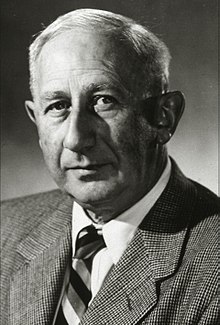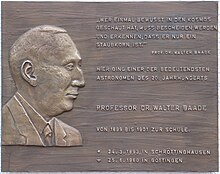Walter Baade
Wilhelm Heinrich Walter Baade (born March 24, 1893 in Schröttinghausen , † June 25, 1960 in Göttingen ) was a German astronomer and astrophysicist .
Start of career in Germany
Walter Baade, son of a teacher, passed his matriculation examination at the Friedrichs-Gymnasium Herford in 1912 and studied mathematics , physics , geophysics and astronomy at the universities of Münster and Göttingen . A congenital hip disability saved him from military service during the First World War . In 1919 he received his doctorate in Göttingen. He got a job at the Hamburg observatory , where he a. a. Discovered the asteroid Hidalgo in 1920 .
During a stay in the United States in 1925, while observing a solar eclipse , he met Harlow Shapley , who helped him get a scholarship . In 1926/27 Baade worked at the Harvard College Observatory , the Yerkes Observatory , the Lick Observatory and the Mount Wilson Observatory and studied star clusters and spiral galaxies .
After his return to Hamburg, Baade was offered a professorship and director post of the Jena observatory in January 1928 ; he declined because the desired equipment could not be fulfilled at that time, even with the help of the Carl Zeiss Foundation .
In the same year he was qualified as a professor at the University of Hamburg . In his inaugural lecture in January 1929, Baade used the term “main nova”, a new concept at the time for what would later be called a supernova .
In the same year he married Johanna Bohlmann, who worked as a technical assistant at the Hamburg observatory .
In 1938 he was elected a corresponding member of the Göttingen Academy of Sciences . In the late 1930s, attempts were made to win Baade as director of the Hamburg observatory; but he did not want to miss the cheap observation opportunities in California. Otto Heckmann became director of the Hamburg observatory in 1942.
Appointment to the Mount Wilson Observatory
In 1931 Baade had received an appointment to the Mount Wilson Observatory. He later also worked at the Mount Palomar Observatory . When Rudolph Minkowski was banned from working after Hitler came to power, Walter Baade brought him to California. Baade probably saved his friend's life with this. During World War II , almost all of Mount Wilson's astronomers were withdrawn to develop weapon systems. Baade, who was still a German citizen, (on arrival he had been advised to remain German in order to keep the institute international) was excluded from this.
So he had almost unlimited observation times and, due to the arranged darkening, optimal observation conditions. By examining one type of variable star , the Cepheid , in other galaxies, he was able to determine their distances. In 1944 Baade succeeded for the first time in resolving the core region of the Andromeda Nebula into individual stars with the help of a 2.5-meter mirror . In 1952, Baade determined that the distances to the galaxies were at least twice as great as previously assumed. This revision of the Hubble parameter doubled the scale and age of the universe . Baade studied the structures of the Milky Way and discovered that our galaxy consists of stars from two different populations . By observing RR Lyrae stars , he determined the distance of the solar system from the center of the galaxy. He also dealt with the identification of various cosmic radio sources with optical objects and photographed them with the 5-meter Hale telescope on Mount Palomar.
Baadean window

Walter Baade found the Baade window in 1951 . It is an almost absorption-free, approximately 1/4 square degree (about the size of a full moon) large galactic window at the galactic coordinates l = 0.9 ° and b = −3.9 °. The line of sight reaches the center of the galaxy, which is about 30,000 light-years away, which is impossible outside of Baade's window due to the absorption by dust clouds. In Baade's window, the globular cluster NGC 6522 is also about 20,000 light years apart. Baade discovered the central star of the Crab Nebula , a supernova remnant from the year 1054, in the early 1930s. Later, in the 1960s, it was discovered that this star is a pulsar and neutron star . This star is now called Baades star . He coined the term “supernova” with the Swiss Fritz Zwicky when they observed Novae. A nova in a distant galaxy appeared to them to be as bright as a nearby one in our Milky Way. The energy radiation of the nova of the distant galaxy was therefore much greater than that of our Milky Way.
The development of the coma-free mirror telescope goes back to intensive discussions and suggestions between Baade and Bernhard Schmidt when they traveled to the Philippines on a solar eclipse expedition in 1929. Baade is also seen as the "originator" of the European Southern Observatory (ESO).
Donald E. Osterbrock , most recently director of the Lick Observatory, met Baade for the first time in 1950 and was taken, if not charmed (entranced), to speak of his personality and manner; 40 years after the death of Walter Baade, he published the biography "Walter Baade - A Life in Astrophysics". In addition to his unquestionable suitability, Baade is "a very pleasant and amiable person", as his Göttingen professors had already introduced him to Director Schorr when he applied to the Hamburg-Bergedorf observatory . A recurring description of Baade is namely: "a very pleasant and amiable person" (Osterbrock), on personality see. also. Osterbrock emphasizes that the discovery of the separate star populations , initially old and young stars, was Baade's greatest contribution (1944) to astrophysics and thus opened up the research area of stellar evolution and beyond, as Halton Arp impressively emphasized in his obituary from 1961: Baade himself said that "cosmogony" or the origin of the universe could be a solution.
From 1951 Baade was a corresponding member of the Bavarian Academy of Sciences .
retirement
Walter Baade was retired from the Carnegie Institution for Science at the end of June 1958 , with the result that he was no longer allowed to observe the large 200-inch telescope. Now, in the 1958/59 semester, he accepted a long-standing invitation from Harvard University . The excellent lecture series with a full treatment of the structure of galaxies and evolution of stars was published after his death under the title Evolution of Stars and Galaxies according to records. This book was instantly widely distributed and a great success among astronomers. It had a major impact on astronomical research for almost two decades.
After his return from Australia, where Baade lectured for about a year at all the universities there, the University of Göttingen offered him the Gauss professorship in 1959 . In 1960 Walter Baade died after an operation. He was buried in Bad Salzuflen , where he wanted to spend his old age with his wife.
Halton Arp wrote the obituary for Walter Baade for the Royal Astronomical Society of Canada ; Arp had been his PhD student. Walter Baade was an honorary member of this scientific society.
At the end of the 1990s, shortly before the leveling, the grave in the Obernbergfriedhof was set up as a permanent grave of honor at the instigation of American and German astronomers. Since 2003, the grave has been adorned with an inscription on a bronze plate, indicating the importance of his achievement for astronomical science. Not only German citizens donated for this, but also German and American astronomers from California, Arizona and Hawaii. Mrs. Gerda-Ilka Borgelt, chairwoman of Sternfreunde Bad Salzuflen, wrote an article about Walter Baade for his 110th birthday. In 2005, the school observatory of the city of Bad Salzuflen in the Lohfeld school center was named after him. Since the beginning of December 2007 there has been a memorial plaque on the former village school he attended in Schröttinghausen (Preußisch Oldendorf).
Honors
- 1953 member of the American Philosophical Society
- 1954 Gold Medal from the Royal Astronomical Society
- 1955 Bruce Medal
- 1958 Henry Norris Russell Lectureship
- 1964 lunar crater Baade named after him, derived from the lunar valley Vallis Baade
- Asteroid (1501) Baade also bears his honorary name
- 2000 The first of the two Magellan telescopes in Chile, which was ready for operation , was named Walter Baade Telescope.
literature
- Otto Heckmann : Walter Baade. In: Communications from the Astronomical Society. Volume 14, 1960, pp. 5-11 ( online , with list of publications).
- Halton Christian Arp : Wilhelm Heinrich Walter Baade, 1893-1960. In: Journal of the Royal Astronomical Society of Canada . Vol. 55, 1961, pp. 113-116. (on-line)
- Donald E. Osterbrock : Walter Baade. A Life in Astrophysics. Princeton University Press, Princeton 2001, ISBN 0-691-04936-X .
- Jochen Schramm: Stars over Hamburg. The history of astronomy in Hamburg. 2nd, revised and expanded edition. Culture & History Office, Hamburg 2010, ISBN 978-3-9811271-8-8 .
Web links
- Literature by and about Walter Baade in the catalog of the German National Library
- Publications by W. Baade in the Astrophysics Data System
- Obituaries for W. Baade in the Astrophysics Data System
Individual evidence
- ^ A b Donald E. Osterbrock: Walter Baade - A Life in Astrophysics. Biography. Princeton University Press, Princeton / Oxford 2001, ISBN 0-691-04936-X , p. 32.
- ↑ Holger Krahnke: The members of the Academy of Sciences in Göttingen 1751-2001 (= Treatises of the Academy of Sciences in Göttingen, Philological-Historical Class. Volume 3, Volume 246 = Treatises of the Academy of Sciences in Göttingen, Mathematical-Physical Class. Series 3rd volume 50). Vandenhoeck & Ruprecht, Göttingen 2001, ISBN 3-525-82516-1 , p. 29.
- ↑ ESO is celebrating its 40th birthday. ( astronomie.de ( Memento from February 14, 2006 in the Internet Archive ))
- ↑ a b Gerda-Ilka Borgelt: On the [110th] birthday of Walter Baade. (astronomie.de)
- ↑ Cecilia Payne-Gaposchkin (Ed.): Walter Baade: Evolution of Stars and Galaxies. Harvard University Press, Cambridge, Mass. 1963. In 1975 a paperback was published.
- ^ Donald E. Osterbrock: Walter Baade - A Life in Astrophysics. 2001, pp. 197-199, 224.
- ^ Ansgar Korte: A memorial for Waalter Baade. (astronomie.de)
- ↑ Walter Baade observatory of the city of Bad Salzuflen in the Lohfeld school center
- ↑ Andreas Hänel: Memorial plaque for the astronomer Walter Baade unveiled.
| personal data | |
|---|---|
| SURNAME | Baade, Walter |
| ALTERNATIVE NAMES | Baade, Wilhelm Heinrich Walter (full name) |
| BRIEF DESCRIPTION | German astronomer and astrophysicist |
| DATE OF BIRTH | March 24, 1893 |
| PLACE OF BIRTH | Schröttinghausen |
| DATE OF DEATH | June 25, 1960 |
| Place of death | Goettingen |


